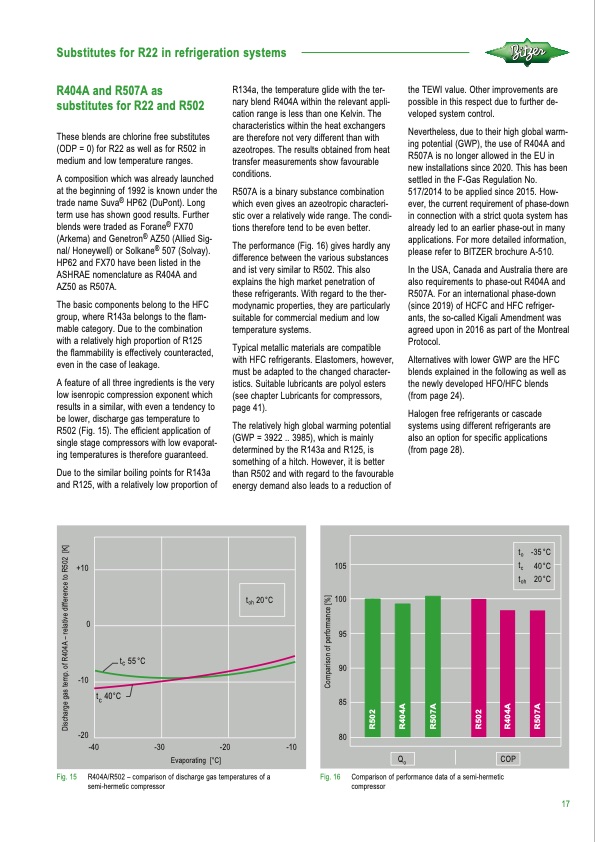
PDF Publication Title:
Text from PDF Page: 017
Substitutes for R22 in refrigeration systems R404A and R507A as substitutes for R22 and R502 These blends are chlorine free substitutes (ODP = 0) for R22 as well as for R502 in medium and low temperature ranges. A composition which was already launched at the beginning of 1992 is known under the trade name Suva® HP62 (DuPont). Long term use has shown good results. Further blends were traded as Forane® FX70 (Arkema) and Genetron® AZ50 (Allied Sig- nal/ Honeywell) or Solkane® 507 (Solvay). HP62 and FX70 have been listed in the ASHRAE nomenclature as R404A and AZ50 as R507A. The basic components belong to the HFC group, where R143a belongs to the flam- mable category. Due to the combination with a relatively high proportion of R125 the flammability is effectively counteracted, even in the case of leakage. A feature of all three ingredients is the very low isenropic compression exponent which results in a similar, with even a tendency to be lower, discharge gas temperature to R502 (Fig. 15). The efficient application of single stage compressors with low evaporat- ing temperatures is therefore guaranteed. Due to the similar boiling points for R143a and R125, with a relatively low proportion of R134a, the temperature glide with the ter- nary blend R404A within the relevant appli- cation range is less than one Kelvin. The characteristics within the heat exchangers are therefore not very different than with azeotropes. The results obtained from heat transfer measurements show favourable conditions. R507A is a binary substance combination which even gives an azeotropic characteri- stic over a relatively wide range. The condi- tions therefore tend to be even better. The performance (Fig. 16) gives hardly any difference between the various substances and ist very similar to R502. This also explains the high market penetration of these refrigerants. With regard to the ther- modynamic properties, they are particularly suitable for commercial medium and low temperature systems. Typical metallic materials are compatible with HFC refrigerants. Elastomers, however, must be adapted to the changed character- istics. Suitable lubricants are polyol esters (see chapter Lubricants for compressors, page 41). The relatively high global warming potential (GWP = 3922 .. 3985), which is mainly determined by the R143a and R125, is something of a hitch. However, it is better than R502 and with regard to the favourable energy demand also leads to a reduction of the TEWI value. Other improvements are possible in this respect due to further de- veloped system control. Nevertheless, due to their high global warm- ing potential (GWP), the use of R404A and R507A is no longer allowed in the EU in new installations since 2020. This has been settled in the F-Gas Regulation No. 517/2014 to be applied since 2015. How- ever, the current requirement of phase-down in connection with a strict quota system has already led to an earlier phase-out in many applications. For more detailed information, please refer to BITZER brochure A-510. In the USA, Canada and Australia there are also requirements to phase-out R404A and R507A. For an international phase-down (since 2019) of HCFC and HFC refriger- ants, the so-called Kigali Amendment was agreed upon in 2016 as part of the Montreal Protocol. Alternatives with lower GWP are the HFC blends explained in the following as well as the newly developed HFO/HFC blends (from page 24). Halogen free refrigerants or cascade systems using different refrigerants are also an option for specific applications (from page 28). ��� ���� �� ���� �� ���� ��� � ��� ��� ��� ��� ��� ��� ����������� ���� �� ����� �� ���� � �� �� �� ��� ��� �� �� �� �� �� ��� Fig. 15 R404A/R502 – comparison of discharge gas temperatures of a Fig. 16 Comparison of performance data of a semi-hermetic semi-hermetic compressor compressor 17 ��������� ��� ����� �� ����� � �������� ���������� �� ���� ��� ���� ����� ����� ���� ����� ����� ���������� �� ����������� ���PDF Image | REFRIGERANT REPORT 21

PDF Search Title:
REFRIGERANT REPORT 21Original File Name Searched:
A-501-21_EN.pdfDIY PDF Search: Google It | Yahoo | Bing
CO2 Organic Rankine Cycle Experimenter Platform The supercritical CO2 phase change system is both a heat pump and organic rankine cycle which can be used for those purposes and as a supercritical extractor for advanced subcritical and supercritical extraction technology. Uses include producing nanoparticles, precious metal CO2 extraction, lithium battery recycling, and other applications... More Info
Heat Pumps CO2 ORC Heat Pump System Platform More Info
| CONTACT TEL: 608-238-6001 Email: greg@infinityturbine.com | RSS | AMP |